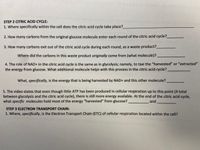
Concept explainers
STEP 2 CITRIC ACID CYCLE:
1. Where specifically within the cell does the citric acid cycle take place?__________________________________
2. How many carbons from the original glucose molecule enter each round of the citric acid cycle?________
3. How many carbons exit out of the citric acid cycle during each round, as a waste product?_________
Where did the carbons in this waste product originally come from (what molecule)?
4. The role of NAD+ in the citric acid cycle is the same as in glycolysis; namely, to taxi the “harvested” or “extracted”
the energy from glucose. What additional molecule helps with this process in the citric acid cycle? ____
What, specifically, is the energy that is being harvested by NAD+ and this other molecule?
5. The video states that even though little ATP has been produced in
between glycolysis and the citric acid cycle), there is still more energy available. At the end of the citric acid cycle,
what specific molecules hold most of the energy “harvested” from glucose? ____ and ___

Trending nowThis is a popular solution!
Step by stepSolved in 3 steps

- Pyruvic acid is a product of glycolysis, but it is not the substance that joins with the pickup molecule to enter the citric acid cycle. What is that substance?arrow_forwardWhich of the following is the second step of Citric Acid Cycle? Select one: a. Isocitrate and then decarboxylated and oxidized to produce alpha-ketoglutarate, Carbon dioxide and NADH b. Succinyl-CoA becomes Succinate and forms one ATP molecule and Coenzyme A-SH c. alpha-ketoglutarate is oxidized and decarboxylated to produce Succinyl-CoA, Carbon dioxide and NADH d. Malate is oxidized to become oxaloacetate forming NADH e. Fumarate is combined with water to become Malate f. Citrate is rearranged to become Isocitrate g. Pyruvate is decarboxylated to become acetyl-CoA producing NADH and Carbon dioxide h. Oxaloacetate combines with the acetyl from acetyl-CoA to produce Citric acid(citrate) i. Succinate is oxidized to become fumarate forming FADH2arrow_forwardIdentify the primary catabolic purpose of the citric acid cyclearrow_forward
- Given the following question on the image identify the following:1. Total number of acetyl coA molecules entering the citric acid cycle2. Total number of net cytosolic ATP molecules produced right after glycolysis3. Total number of all NADH molecules produced after complete oxidation4.Total number of all FADH2 molecules produced after complete oxidation5. Total number of all mitochondrial GTP molecules produced6. Total number of net ATP molecules produced after complete oxidationarrow_forwardRemember that the chemical energy stored in glucose is found in the chemical bonds. Explain why aerobic cellular respiration releases much more energy for the cell to use than anaerobic. anaerobic cellular respiration examples Lactic Acid Fermentation 20,H,O, + 2 ATP Alcohol Fermentation 2C,H,OH + 2CO, + 2 ATP aerobic respiration tv Aa MacBook Air 80 888 DII DD F2 F3 F5 F7 F8 F9 F10 F11 23 $ & * 3 4 5 7 8 E R Y U { D K L C V M .. .-arrow_forwardQuestion 1: Look at table 17.2 to see the standard free energy changes for the steps in the CAC. Three consecutive steps in the cycle appear to be the most readily reversible (having standard free energy changes closest to zero). Which are these steps?arrow_forward
- Using the following glycolisis diagram, a. name all the steps in citric acid cycle, what are the intermediates. refer to the diagram given. b. Is glycolysis endothermic or exothermic.arrow_forwardOther than oxidative phosphorylation, what other metabolic pathway does "Complex 2" participate in? 1. Glycolysis 2. Gluconeogenesis 3. Lactic acid fermentation 4. Citric acid cyclearrow_forwardFor each step of the citric acid cycle, name the enzyme responsible for the chemical transformation that occurs and classify the enzyme type: Step 1. Step 2. Step 3. Step 4. Step 5. Step 6. Step 7. Step 8. i. oxidoreductase (oxidases, reductases, dehydrogenases) ii. transferase (transaminases, kinses) iii. hydrolase (lipases, proteases, nucleases, carbohydrases, phosphateses) iv. lyase (dehydratase, decarboxylase, deaminase, hydratase) v. isomerase (racemases, mutases) vi. ligase (synthetases, carboxylaces) Enzyme Name Enzyme Typearrow_forward
- a. Calculate how many carbons from an original glucose molecule will enter into the TCA cycle? (please provide your answer in number like 1, 2, 3) b. Based on the question you answered above what happens to the carbons that do not enter the cycle (write what it converts into)?arrow_forwardTrue or False: 1. In the pathways of cell metabolism, 1) the citric acid (or Kreb's) cycle does NOT occur in the mitochondria, AND 2) the proton gradient in oxidative phosphorylation occurs through a PASSIVE transport process. 2. The chemical reaction where an aldehyde or ketone reacts with an alcohol in the presence of an inorganic acid source, is called acetal formation.arrow_forwardWrite the equation for net citric acid cycle and calculate one cycle equivalent to how many ATP?arrow_forward
 Human Anatomy & Physiology (11th Edition)BiologyISBN:9780134580999Author:Elaine N. Marieb, Katja N. HoehnPublisher:PEARSON
Human Anatomy & Physiology (11th Edition)BiologyISBN:9780134580999Author:Elaine N. Marieb, Katja N. HoehnPublisher:PEARSON Biology 2eBiologyISBN:9781947172517Author:Matthew Douglas, Jung Choi, Mary Ann ClarkPublisher:OpenStax
Biology 2eBiologyISBN:9781947172517Author:Matthew Douglas, Jung Choi, Mary Ann ClarkPublisher:OpenStax Anatomy & PhysiologyBiologyISBN:9781259398629Author:McKinley, Michael P., O'loughlin, Valerie Dean, Bidle, Theresa StouterPublisher:Mcgraw Hill Education,
Anatomy & PhysiologyBiologyISBN:9781259398629Author:McKinley, Michael P., O'loughlin, Valerie Dean, Bidle, Theresa StouterPublisher:Mcgraw Hill Education, Molecular Biology of the Cell (Sixth Edition)BiologyISBN:9780815344322Author:Bruce Alberts, Alexander D. Johnson, Julian Lewis, David Morgan, Martin Raff, Keith Roberts, Peter WalterPublisher:W. W. Norton & Company
Molecular Biology of the Cell (Sixth Edition)BiologyISBN:9780815344322Author:Bruce Alberts, Alexander D. Johnson, Julian Lewis, David Morgan, Martin Raff, Keith Roberts, Peter WalterPublisher:W. W. Norton & Company Laboratory Manual For Human Anatomy & PhysiologyBiologyISBN:9781260159363Author:Martin, Terry R., Prentice-craver, CynthiaPublisher:McGraw-Hill Publishing Co.
Laboratory Manual For Human Anatomy & PhysiologyBiologyISBN:9781260159363Author:Martin, Terry R., Prentice-craver, CynthiaPublisher:McGraw-Hill Publishing Co. Inquiry Into Life (16th Edition)BiologyISBN:9781260231700Author:Sylvia S. Mader, Michael WindelspechtPublisher:McGraw Hill Education
Inquiry Into Life (16th Edition)BiologyISBN:9781260231700Author:Sylvia S. Mader, Michael WindelspechtPublisher:McGraw Hill Education





